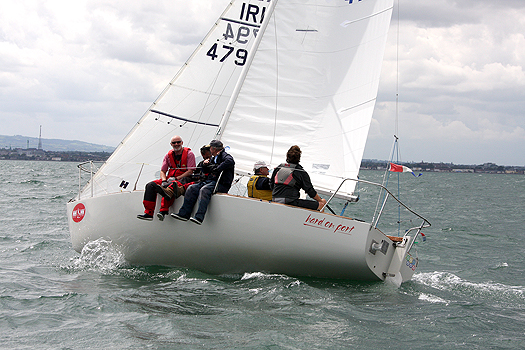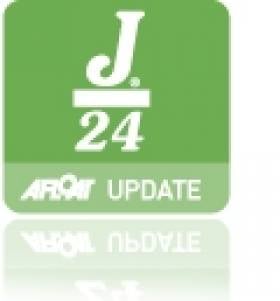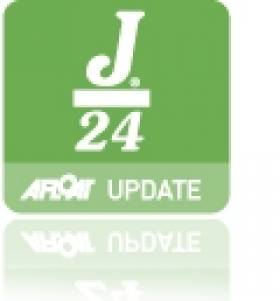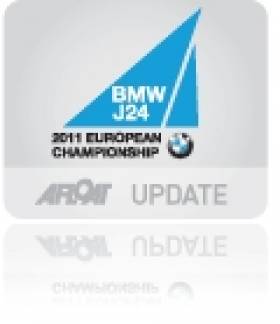Displaying items by tag: onedesign keelboat
#J24 – Britain's Ian Southworth totally dominated the J24 National Championships at Howth over the weekend, with five race wins in the 8-race series, while the Howth U-25 Keelboat team, as the highest placed Irish boat in the event in 6th place, were crowned National Champions.
In what was a useful practice before the BMW J24 World Championship in a week's time, Southworth and his crew on 'Il Riccio' from the Royal Corinthian YC demonstrated remarkable boat speed in the strong and gusty westerly and south-westerly winds. Three bullets and a second place meant they topped the leaderboard after the first day's racing ahead of compatriot Bob Turner ('Serco') from Castle Cove SC.
The Howth U25 crew sailing 'Euro Car Parks Killcullen' had a consistent first day, although defending Irish champion J-P McCaldin was narrowly the best of the local boats after day 1. The young HYC team moved up a gear on the second day to record 4, 5, 7 and 9 to finish five points clear of nearest Irish rival Flor O'Driscoll ('Hard on Port') while another Howth boat, 'Stouche' (Darrer/Murphy) took 8th overall and 3rd of the Irish entries.
The statistics show that Southworth only beat American Keith Whittemore from Seattle by 0.5 points overall but they didn't compete in the last two races (they had to catch a plane home!) giving an artificially narrow margin that didn't do justice to their dominance over the two days.
Another American, Tony Parker, finished behind third-placed Bob Turner and a single point ahead fifth placed Paul Williams from Britain.
Southworth is familiar with the Howth waters, having won the BMW J24 Europeans there two years ago and his crew's performance at the Nationals underlines what a threat they will be at the forthcoming Worlds.
Howth J24 Nationals Attracts Top Overseas Entries
#J24 – Four top crews from the USA and Britain will be in action at the J24 National Championship at Howth this weekend as they use the event as an ideal warm-up and familiarisation session before the BMW J24 World Championship takes place on the same waters a week later.
Ian Southworth, from Royal Corinthian YC, who won the Europeans in Howth two years ago, and Bob Turner from Castle Cove SC, head the British challenge while Tony Parker from Annapolis and Keith Whittemore from Seattle are the two American skippers taking the event seriously.
Lough Erne's J-P McCaldin is the defending Irish Champion and he can expect stiff competition from multiple champion Flor O'Driscoll of the host club. Many eyes, however, will be on the performance of the Howth Under-25 Keelboat Team that has been making steady progress in the build-up to the Worlds.
A baptism of fire in the Europeans in 2011 has been followed by ongoing development and improvement, culminating in success recently in winning the J24 Eastern Championship. The team comprises Cillian Dickson, Joseph Murphy, Harry O'Reilly, Ross Darmody and Gordon Stirling.
The Irish Nationals has eight races scheduled and has attracted 20 entries from 10 different clubs.
Top international J/24 award for Eagleson
Robin Eagleson, the Chairman of the Irish J/24 Class Association (and Vice-Chairman of the International Class Association - IJCA), has been awarded the J/24 Class’s top accolade - the Geoff Evelyn Memorial Trophy – for outstanding service. The trophy is awarded annually to the member who, in the opinion of the IJCA Chairman, has made the greatest contribution to the J/24 Class in the past year.
Jim Farmer, Chairman of the IJCA, presented the trophy to Robin Eagleson at the J/24 World Council Meeting, held recently at Rochester Yacht Club in New York, site of next year’s J/24 World Championship.
According to Farmer, “Robin has over the past year gone above and beyond the call of duty to address issues which were critical to the continued stability and success of the International J/24 Class Association. His persistence, diligence and superb communication skills enabled him to attack these issues straight on and offer a solution that no one else had the ability to do”.
The next meeting of the J/24 World Council is scheduled to be held on October 13, 2012 at Howth Yacht Club, the host club for the 2013 J/24 World Championship.
BMW J24 Europeans' Entries Reach 40-Boat Mark
Entries for the BMW J24 European Championships, to be hosted by Howth Yacht Club in two weeks’ time, have now reached the 40-boat mark from eight nations, making for an impressive fleet when racing starts on September 12th.
Irish and British entries account for 13 boats each, there are eight from Germany and two from Italy, while Holland, USA, France and Greece each have one representative.
“We are delighted with the entry level,” said Organising Committee Chairman Derek Bothwell. “Forty boats represent 200 sailors plus additional numbers with family members in Howth for the event, so it is a major occasion in every respect.” A social programme has also been arranged to keep the visitors entertained after racing each day.

Flor O'Driscoll's Hard on Port will be sailing in Howth
The 10-race series starts on Monday 12th under the control of PRO David Lovegrove and his team, and is preceded by three days of registration and measurement and a practice race on Sunday 11th.
Irish entries will have the opportunity of extra practice on the European race track the previous weekend when neighbouring club Malahide YC hosts the J24 Eastern Championships over two days



























































